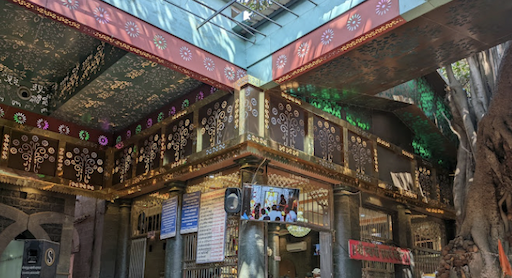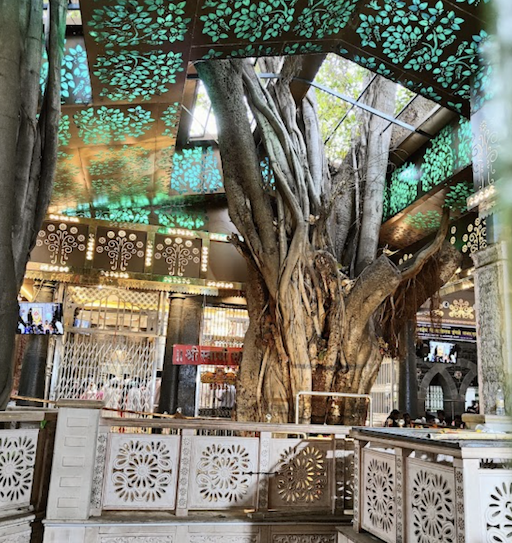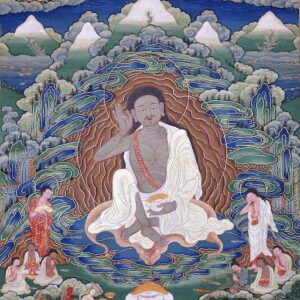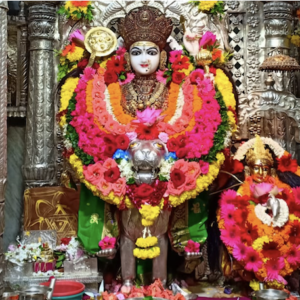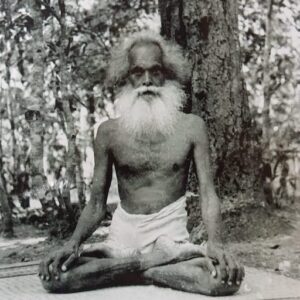This is a place where Swami Samarth got enlightened. The tree where he got enlightened is inside the temple.
There is space to sit and meditate. You can go into meditative states effortlessly here.
How to get there
The temple is located 1.1 km South of Akkalkot Bus Stand.
Map: https://maps.app.goo.gl/RUmvEzrzEoWMQ9et6
About Shree Swami Samarth
Shrimad Nrusimha Saraswati – Incarnation of Lord Dattareya
In a place called Karanja Nagar (Karnataka State) in Southern India, there lived a pious Brahmin couple, Madhava and Ambabhavani, in the 13th century.
Asceticism
To this God-fearing & religious couple, was born a son around 1275 A.D. This child was the incarnation of Lord Dattatreya and came to be known as the great sage Shrimad Nrusimha Saraswati. The child was unique in the sense that, he was chanting only ‘Aum’ (the Hindu holy chant) since his birth. The parents were concerned about his dumbness till his ‘Vratabandha’ (the sacred thread bearing ceremony), when this child was merely eight years old, he started reciting all the four Vedas (the Holiest Hindu scriptures) to the great astonishment of all the learned people.
After the aforesaid incident, the child left for Kashi (Uttar Pradesh State, Northern India) for Tapas [penance]. Pleased with his rigorous tapasya [penance], a learned ascetic named Shree Krishna Saraswati Swami, initiated him into Sanyasashram (Ascetism) and gave him the name, Shrimad Nrusimha Saraswati.
Biography
The biography of Shrimad Nrusimha Saraswati “Shree Gurucharitra”, gives us the details of his work in guiding the devotees and the various miracles he performed to help the devotees. He stayed at Ganagapur (Karnataka State, Southern India) for a long time and then gave his “Nirguna Padukas” to his disciples and devotees, before leaving for the Kardali forests to perform Tapas [penance]. His disciples prepared a floating seat of flowers for him on which he sailed against the current of the river Patalganga and disappeared.
Rigorous Penance
He performed rigorous tapasya [penance] on the Shree Shail mountain in the Kardali forests for nearly 150 years. After this he took an extensive pilgrimage, covering even places, now known as Jawa, Sumatra, Indonesia, China, Japan, Australia etc., relieved many people from their miseries, and guided them on the spiritual path. Finally, he came to the ranges of Himalayas where he enlightened many devotees. Later he sat under a Deodar tree for tapasya [penance]. This Tapasya [penance] in the Himalayas lasted for nearly 250 years, but a woodcutter unknowingly axed the anthill enveloping the body of Shrimad Nrusimha Saraswati. This resulted in the break in Tapasya [penance] and Shrimad Nrusimha Saraswati then left for an extensive travel throughout the Indian sub-continent guiding the devotees.
Akkalkot Niwasi Shree Swami Samarth
During this travel, he became popular by various names at various places. Thus at one place he was known as Chanchal Bharati and at another place he would be called Digambar Swami. As he travelled and stayed at various places, he became the Guru (preceptor) of many great souls like Shree Ramkrishna Paramahansa, Shree Saibaba of Shirdi, Shree Shankar Maharaj, Shree Gajajan Maharaj of Shegaon etc. Finally he settled down at Akkalkot (Maharashtra State) and stayed there for 24 years from 1854 A.D. to 1878 A.D. and thus came to be known as the Akkalkot Niwasi Shree Swami Samarth Maharaj (the great sage of Akkalkot).
Here he enlightened many disciples, such as Shree Dev Mamledar, Shree Balappa Maharaj, Shree Cholappa Maharaj, Shree Nrusimha Saraswati Maharaj of Alandi, Shree Ramanand Beedkar Maharaj of Pune etc.
Mahasamaadhi
On April 30, 1878 (Chaitra Vadya Trayodashi of Hindu year 1800) after nearly 600 years of the incarnation, the great sage adopted MahaSamadhi [the last conscious communion with God] under his favourite Banyan tree.
Devotees still experience his divine presence and feel reassured because of his quote “I have not gone, I am still present”.
Swami Samarth


